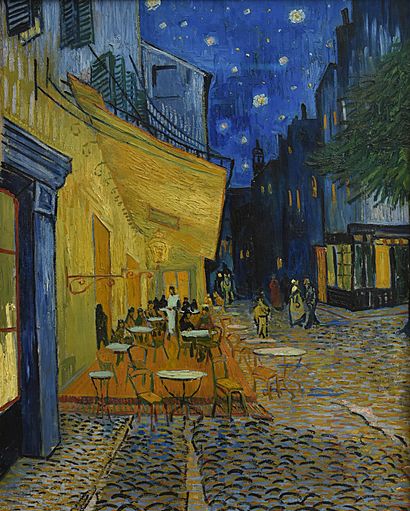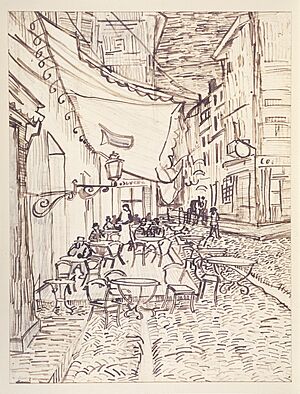Café Terrace at Night facts for kids
Quick facts for kids Café Terrace at Night |
|
|---|---|
 |
|
| Artist | Vincent van Gogh |
| Year | 1888 |
| Catalogue |
|
| Medium | Oil on canvas |
| Dimensions | 80.7 cm × 65.3 cm (31.8 in × 25.7 in) |
| Location | Kröller-Müller Museum, Otterlo |
Café Terrace at Night is a famous oil painting created in 1888 by the Dutch artist Vincent van Gogh. It is also known as The Cafe Terrace on the Place du Forum. When it was first shown in 1891, it was called Coffeehouse, in the evening.
Van Gogh painted this artwork in Arles, France, in mid-September 1888. Even though the painting isn't signed, Van Gogh wrote about it in three of his letters. Today, you can see the painting at the Kröller-Müller Museum in Otterlo, Netherlands.
Contents
What the Painting Shows
This painting shows a lively outdoor cafe at night. Van Gogh set up his easel at the north-eastern corner of the Place du Forum in Arles. He looked towards the brightly lit terrace of a popular coffee house.
You can see the yellow light from a large lantern lighting up the cafe. This light spills onto the pavement and the street's cobblestones. On the right, Van Gogh included a lit shop and tree branches. The scene captures the feeling of a warm, inviting night.
Visitors to Arles can still stand at the exact spot where Van Gogh painted. The area was updated in the early 1990s to look like it does in his painting.
How Van Gogh Painted It
Van Gogh was very excited about this painting. He wrote to his sister about how he loved painting at night. He wanted to show night scenes without using black paint.
He wrote: "Now there’s a painting of night without black. With nothing but beautiful blue, violet and green, and in these surroundings the lighted square is coloured pale sulphur, lemon green." He enjoyed painting directly on the spot at night. This was different from how many artists worked back then. They usually made drawings during the day and painted from those later.
Van Gogh felt that painting at night helped him avoid the usual dark, dull way night was shown. He believed even a single candle could create rich yellows and oranges.
He also mentioned that the painting reminded him of a description of a starry night in Paris from a book called Bel Ami by Guy de Maupassant.
Night Sky in Art
Café Terrace at Night was the first painting where Van Gogh used starry backgrounds. He later painted other famous works with star-filled skies. These include Starry Night Over the Rhône, painted in the same month, and the even more famous The Starry Night a year later. He also used a starlight background in his Portrait of Eugène Boch.
Van Gogh paid close attention to how the sky looked. Experts have even used the position of the stars in the painting to figure out the exact time he painted it. They believe it was around 11:00 PM in early September 1888.
Colours in the Painting
Van Gogh described the colours he used for the night scene. He said it was "a night painting without black, with nothing but beautiful blue and violet and green". He noted that the lit area of the cafe turned "sulfur pale yellow and citron green" because of the surrounding colours.
See also
 In Spanish: Terraza de café por la noche para niños
In Spanish: Terraza de café por la noche para niños
- List of works by Vincent van Gogh



